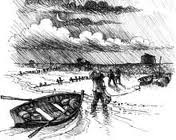
Happy Tuesday morning, everyone! I hope it’s nice and cool where you are–it’s another 100+ scorcher here (I am sooooo ready for autumn), perfect for staying in the AC and getting some work done. Like Diane, I’m still recovering from RWA and missing all my friends and the fun we had. It’s not always easy to settle down to working on the WIP and getting used to my quiet house. (Though I did have fun hitting the school supply sale at Target this weekend! I bought new pens and pretty, shiny new Disney Princess notebooks, perfect for this new book…)
I had a ridiculous amount of fun on my one day at Disney World, which really was a “magical day”! (Big thanks to Michelle Willingham for introducing us to the “Unofficial Guide” plan, which means never waiting in long lines and getting to see everything in a reasonable amount of time!). I loved the rides, seeing the adorable children in their costumes (especially the tiny pirate twins sword-fighting on the sidewalk), and eating lunch at Cinderella’s Castle. I must, must, must get back there for a real vacation ASAP! One thing I was especially struck by was the storytelling of many of the rides (and also how clean and tidy everything was). The details of rides like Pirates of the Caribbean, Splash Mountain, and Snow White’s Scary Adventure were amazing, and a good lesson in building worlds and adding depths and layers to our own stories.
One of the best rides for this was the Haunted Mansion. I’m glad I did a little reading about it before we left, because it’s so easy to get caught up in the moment and miss lots of fun, clever little details! I think the Mansion at Disney in France actually does feature a narrative through the whole ride (a tale of a bride and a Phantom), but the Orlando attraction is more of a vignette-style, but a good example of storytelling for all that. Here is a little of what I observed from my “Doom Buggy”:
 The Haunted Mansion opened in 1971, and underwent a large refurbishment in 2007. It can be found in Liberty Square, a portrayal of colonial America, and the exterior is built in a “Dutch Gothic Revival” style reminiscent of millionaire’s mansions in the Hudson River Valley (according to the Disney World site…). On the walk in you go by a hearse and a little graveyard, which includes a tombstone for Madame Leota which is supposed to open its eyes and blink at you (though I didn’t catch that feature!). Once inside the crowds are pressed into an octagonal room hung with portraits and the wall behind you slides closed (the scariest part of the whole ride, IMO!). A ghostly voice intones “Welcome, foolish mortals, to the Haunted Mansion!” and goes on to say “Is this haunted room actually stretching? Or is it your imagination, hmmm?” The walls do stretch upwards, revealing humorously macabre scenes in the portraits–then the lights go out, lightning flashes, and there’s a glimpse of a hanged silhouette on the wall. I think I did shriek a little at that point…
The Haunted Mansion opened in 1971, and underwent a large refurbishment in 2007. It can be found in Liberty Square, a portrayal of colonial America, and the exterior is built in a “Dutch Gothic Revival” style reminiscent of millionaire’s mansions in the Hudson River Valley (according to the Disney World site…). On the walk in you go by a hearse and a little graveyard, which includes a tombstone for Madame Leota which is supposed to open its eyes and blink at you (though I didn’t catch that feature!). Once inside the crowds are pressed into an octagonal room hung with portraits and the wall behind you slides closed (the scariest part of the whole ride, IMO!). A ghostly voice intones “Welcome, foolish mortals, to the Haunted Mansion!” and goes on to say “Is this haunted room actually stretching? Or is it your imagination, hmmm?” The walls do stretch upwards, revealing humorously macabre scenes in the portraits–then the lights go out, lightning flashes, and there’s a glimpse of a hanged silhouette on the wall. I think I did shriek a little at that point…
They say if you hang back a little in the stretching room you can hear the gargoyles on the walls whisper and a voice telling you “Get out!”–but the staff doesn’t want you to linger. They hustle you along a dark hallway with portraits that turn from people into ghouls as you watch and into your two-person “Doom Buggy”. (I now like to imagine what riders would see of my WIP if they rode a doom buggy through the pages…)
There are rooms of Escher-like stairways floating in mid-air, floating candelabras, talking portraits, a library with moving ladders and flying books and a stormy forest beyond the windows (while “Grim Grinning Ghosts” plays throughout in the background). The Buggies spin backwards to reveal new scenes, like a conservatory full of dead flowers and a coffin with someone trying to get out (while nails hang out of the coffin’s roof!), with a raven looking on. A corridor is full of ghosts trying to escape, knocking, swirling around, breathing doors, and a demonic clock that chimes 13 as the hands spin backward and a claw’s shadow passes over it.
 Then there is my favorite part–the ballroom! Diners sit around a table consuming a phantom feast, while a ghost plays the organ and ghostly couples spin around and around (and latecomers arrive in an open coffin on a hearse). I loved the portraits of the two dueling men, which shoot at each other across the wall. Then comes the attic, full of dusty items and portraits of a murderous bride with her various husbands (each husband morphs into being headless as a voice intones “Until death do we part!”). The buggies go out a window and into a cemetery where so much is happening it’s impossible to keep track–I glimpsed a king and queen on a teeter-totter, children on swings, a tea party, a dog, an arm coming out of the crypt holding a wineglass, spirits on bikes.
Then there is my favorite part–the ballroom! Diners sit around a table consuming a phantom feast, while a ghost plays the organ and ghostly couples spin around and around (and latecomers arrive in an open coffin on a hearse). I loved the portraits of the two dueling men, which shoot at each other across the wall. Then comes the attic, full of dusty items and portraits of a murderous bride with her various husbands (each husband morphs into being headless as a voice intones “Until death do we part!”). The buggies go out a window and into a cemetery where so much is happening it’s impossible to keep track–I glimpsed a king and queen on a teeter-totter, children on swings, a tea party, a dog, an arm coming out of the crypt holding a wineglass, spirits on bikes.
As you exit, a tiny girl ghost above the door whispers “Hurry back! be sure to bring your death certificate if you decide to join us. Make final arrangements now. We’ve been dying to have you…” Very creepy. And then an uninvited guest joins you in the buggy to follow you home….
I loved this ride! If only I could have gone on it at least a couple more times to catch some of the details I missed. (I found out after I got home there is a whole fan site for this ride, Doom Buggies, with lots of great info!)
Have you been to Disney World? What is your favorite ride there, and what little details have you noticed? Where have you found some unexpected inspiration???

















